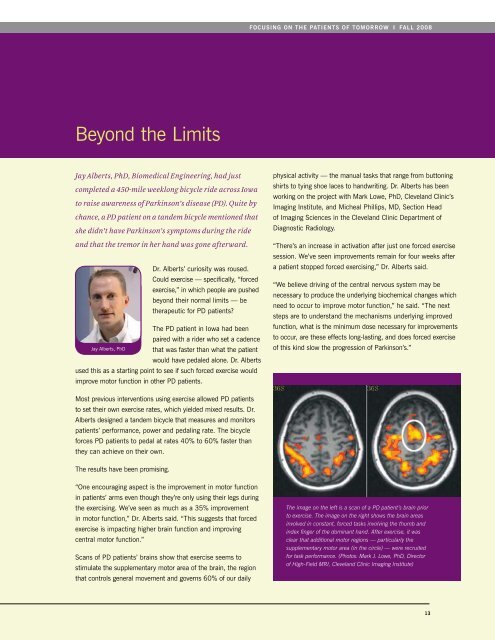Fall 2008 - Cleveland Clinic Lerner Research Institute
Fall 2008 - Cleveland Clinic Lerner Research Institute
Fall 2008 - Cleveland Clinic Lerner Research Institute
You also want an ePaper? Increase the reach of your titles
YUMPU automatically turns print PDFs into web optimized ePapers that Google loves.
Focusing on the patients of tomorrow FALL <strong>2008</strong>Beyond the LimitsJay Alberts, PhD, Biomedical Engineering, had justcompleted a 450-mile weeklong bicycle ride across Iowato raise awareness of Parkinson’s disease (PD). Quite bychance, a PD patient on a tandem bicycle mentioned thatshe didn’t have Parkinson’s symptoms during the rideand that the tremor in her hand was gone afterward.Jay Alberts, PhDDr. Alberts’ curiosity was roused.Could exercise — specifically, “forcedexercise,” in which people are pushedbeyond their normal limits — betherapeutic for PD patients?The PD patient in Iowa had beenpaired with a rider who set a cadencethat was faster than what the patientwould have pedaled alone. Dr. Albertsused this as a starting point to see if such forced exercise wouldimprove motor function in other PD patients.physical activity — the manual tasks that range from buttoningshirts to tying shoe laces to handwriting. Dr. Alberts has beenworking on the project with Mark Lowe, PhD, <strong>Cleveland</strong> <strong>Clinic</strong>’sImaging <strong>Institute</strong>, and Micheal Phillips, MD, Section Headof Imaging Sciences in the <strong>Cleveland</strong> <strong>Clinic</strong> Department ofDiagnostic Radiology.“There’s an increase in activation after just one forced exercisesession. We’ve seen improvements remain for four weeks aftera patient stopped forced exercising,” Dr. Alberts said.“We believe driving of the central nervous system may benecessary to produce the underlying biochemical changes whichneed to occur to improve motor function,” he said. “The nextsteps are to understand the mechanisms underlying improvedfunction, what is the minimum dose necessary for improvementsto occur, are these effects long-lasting, and does forced exerciseof this kind slow the progression of Parkinson’s.”Most previous interventions using exercise allowed PD patientsto set their own exercise rates, which yielded mixed results. Dr.Alberts designed a tandem bicycle that measures and monitorspatients’ performance, power and pedaling rate. The bicycleforces PD patients to pedal at rates 40% to 60% faster thanthey can achieve on their own.The results have been promising.“One encouraging aspect is the improvement in motor functionin patients’ arms even though they’re only using their legs duringthe exercising. We’ve seen as much as a 35% improvementin motor function,” Dr. Alberts said. “This suggests that forcedexercise is impacting higher brain function and improvingcentral motor function.”Scans of PD patients’ brains show that exercise seems tostimulate the supplementary motor area of the brain, the regionthat controls general movement and governs 60% of our dailyThe image on the left is a scan of a PD patient’s brain priorto exercise. The image on the right shows the brain areasinvolved in constant, forced tasks involving the thumb andindex finger of the dominant hand. After exercise, it wasclear that additional motor regions — particularly thesupplementary motor area (in the circle) — were recruitedfor task performance. (Photos: Mark J. Lowe, PhD, Directorof High-Field MRI, <strong>Cleveland</strong> <strong>Clinic</strong> Imaging <strong>Institute</strong>)13
















